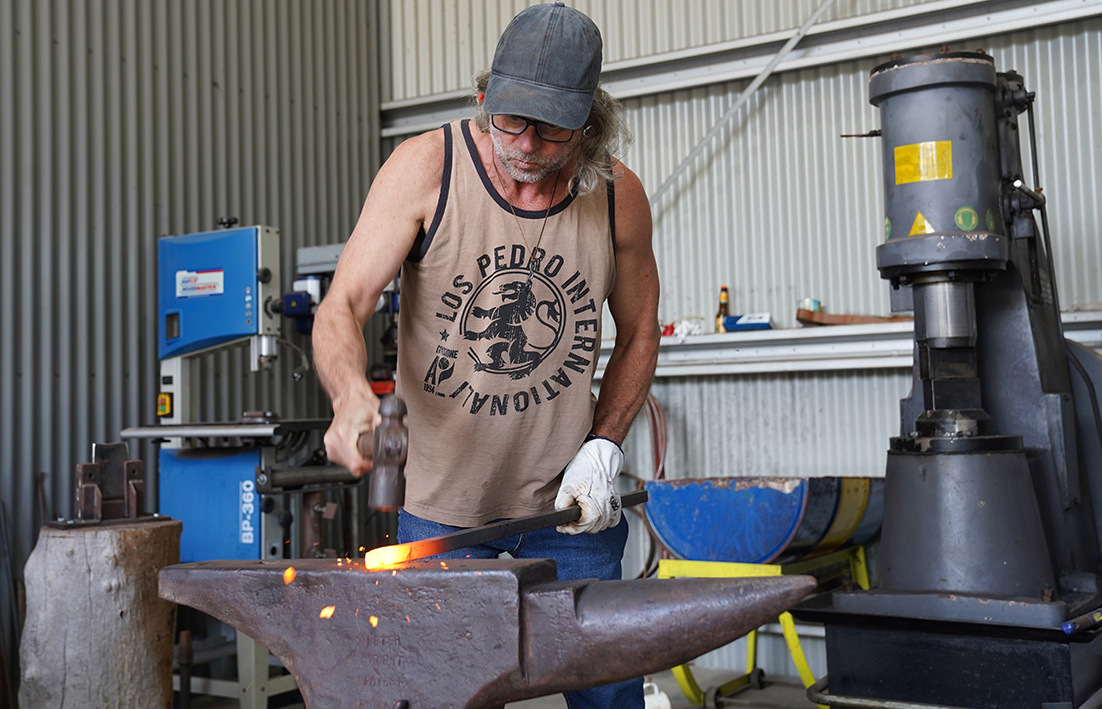
FROM the forges of Gidgegannup’s blacksmith artist Caine Scott, pieces inspired by rural Australian life and history are being showcased as part of Mundaring Hills Open Studios.
Echo News visited the studio, where rusted pieces of pipes, wagon wheel frames, and other iron structures lay side by side, propped up against shipping containers in the hills backdrop.
Mr Scott ran his fingers along a rusted iron pipe and felt the divots and textures along the piece with an appreciative smile.
“Some people just have these beautiful old pipes laying in their backyard ready to throw away,” he said.
“To some people it’s their rubbish, but to me it’s my gold.
“Only with age do you get the pitting and the rusting that gives the iron so much character.”
Mr Scott was born and raised in the Perth Hills and moved to Broome where he discovered and fell in love with the art of blacksmithing.
“The funny thing is there are a fair few artists in the family, but I wasn’t creative like them early on,” Mr Scott said.
“I was always great with my hands and did well in any trades-based classes in school, but I just didn’t have the art in me.
“In 1996, that’s when I moved to Broome as a panel beater and a spray painter at the time and there was a guy who lived a couple of sheds up from me who needed his bike fixed.
“I offered to fix his bike, and he said, ‘Come on down to my place, and I’ll show you what I do’.
“The next night, I was there swinging the hammer and never looked back — before I knew it, I was sketching up my own designs and making blacksmith art.”
Mr Scott said growing up in the Perth Hills gave him an appreciation of adventure, the beauty in rural living, and WA’s agricultural identity and history.
“It was great growing up in the hills and I had a lot of freedom with motorcycles and bush bikes,” he said.
“The hills were a great place to grow up, right next to the countryside where I’d go and see friends who lived on farms and also see them drive in their wagons.
“I still go to the Northam swap meets where there’s plenty of beautiful iron pieces to pick up, and I love the history of it all.”
Watching Mr Scott work was an experience in seeing ‘found’ objects glowing from the fires of his forge and being beaten, bent, and twisted into new forms to be incorporated into something larger.
Many of his pieces featured tendrils of iron swirling around different shapes such as spheres or even the unaltered end of a spanner that had been given new life through the forge.
“The iron has to flow like a ribbon dancer,” he said.
“There has to be that energy in the work, otherwise it isn’t where it needs to be — and it’s all about the details.
“If I’m working on a table or a piece with a period look, every bit of it needs to look the part.
“Even if I incorporate new material and combine it with the aged pieces, I beat and bend them until they look like they’ve also been aged because it’s no good if someone looks at a piece, and then looks under it to see a fresh steel bolt that looks clearly out of place.”
Mr Scott said blacksmithing is a fading art form but will be holding a blacksmith artmaking workshop at his studio on Friday, October 25 where visitors can come and see the forge fired up and iron being worked into art in real time.
“The most beautiful thing is when you fire up the coal forge and you heat up the piece of iron until it’s yellow hot,” he said.
“At that point you can see the molecules bubbling on the surface, and when you hit it with the hammer, the explosion of sparks is spectacular.”
More information about Mr Scott’s weekend studio opening can be found at this website.